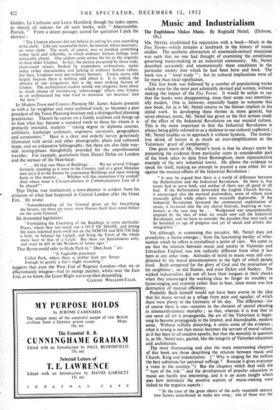Plans and Planners
A Prospect of Cities. By Cecil Stewart. (Longmans. 25s.) Modern Town and Country Planning. By James W. R. Adams. (J. and A. Churchill. 42s.) To start out from the Greek and Roman Utopias and to reach 1952 and Harlow New Town still fresh and debonair by way of Byzantium, Hereford, Caerwent, Genoa, Richelieu, Versailles, Bath, New Lanark, " and intermediate stations," and to be as enter- taining as edifying for the whole of the tremendous space-time journey, is a feat indeed. But it is what Mr. Cecil Stewart has accomplished in his Prospect of Cities with a grace and clarity that should beguile many a common reader into learning something to his advantage about the new-old mystery of town and country planning. And much else besides—the philosophy of history for instance—for there are all manner of odd and engaging asides, sometimes formally presented as Gibbonian antitheses or perhaps as a'Chestertonian paradox, always effectively and often memorably, or else again by cunningly unearthed quotations. The illustrations are most happily apt to the text, in which, how- ever, the ingenious author has somehow avoided all mention of Geddes, Le Corbusier and Lewis Mumford, though the index opens, as should all indexes for all such books, with " Abercrombie, Patrick. " From a dozen passages scored for quotation I pick the shortest :
"The Utopian planner did not believe in cutting his coat according to his cloth. Like any reasonable tailor, he insisted, where necessary, on more cloth. The result, of course, was to produce something rather hard and inflexible, in which ordinary human failings were noticeably absent. One seldom came across the fat or the ungainly in these older Utopias. In fact, the picture presented by those wide, clean-swept streets, flanked by stupendous architecture, seems today rather characterless and lacking in ordinary human vans; but then, Utopians were not ordinary humans. Utopia seems odd largely because there is nothing odd about it. It is, indeed, the absence of any irregularity that is the most striking feature of Utopia. The architectural student would, one imagines, have about as much chance of introducing 'scharawaggi' effects into Utopia as an architectural bee who tried to insinuate 'art nouveau' into the hive."
In Modern Town and Country Planning Mr. James Adams presents us with a far weightier and more technical work, as becomes a past president of the Town Planning Institute and a distinguished planning practitioner. Therein he carries on a family tradition and brings up to date what has become a standard work to those for whom it is primarily intended, students " taking degree or diploma courses, architects, landscape architects, engineers, surveyors, geographers and economists." Here is a clear and orderly survey generously illustrated with aerial and other photographs, plans and coloured maps, and an exhaustive bibliography; but there are also little way- side resting-places thoughtfully provided for the unprofessional traveller. For example, quotations from Daniel Defoe on London and the menace of the Man-heap: .. All that vast Mass of Buildings.... We see several Villages formerly standing as it were in the Country and at a great Distance now joyn'd to the Streets by continuous Buildings and more making haste in like manner. . . . Whither will this monstrous City extend? And where must a Circumvallation or Communication Line of it be placed?"
That Defoe was instinctively a town-planner is evident from his criticism of what had happened in Central London after the Great Fire. He wrote: •
"Notwithstanding all the Ground given up for beautifying the Streets, yet there are many more Houses built than stood before on the same Ground."
He demanded legislation:
"Forbidding the Extending of the Buildings in some particular Places, where they too much run it OUT OF SHAPE, and letting the more indented parts swell out on the NORTH and SOUTH Side a little, to balance the Length, and bring the Form of the whole more near to that of a Circle. But these are Speculations only, and must be Jeft to the Wisdom of future ages."
That Byron could refer to Hyde Park in " Don Juan " as:
"A Vegetable puncheon Called Park, where there is neither fruit nor flower Enough to gratify a bee's slight munching"
suggests that even the West End of Regency London—that we so affectionately imagine—had its mangy patches, whilst over the East End, as we know, the Great Blight was even then descending.
CLOUGH WILLIAMS-E LLIS.



































 Previous page
Previous page